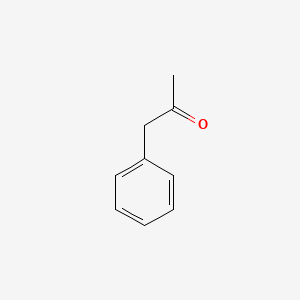



1. 1-phenyl-2-propanone
2. Benzyl Methyl Ketone
1. 1-phenylpropan-2-one
2. 103-79-7
3. 1-phenyl-2-propanone
4. Benzyl Methyl Ketone
5. Methyl Benzyl Ketone
6. Phenyl-2-propanone
7. 1-phenylacetone
8. 2-propanone, 1-phenyl-
9. 3-phenyl-2-propanone
10. Phenylmethyl Methyl Ketone
11. Phenyl Acetone
12. 1-phenyl-propan-2-one
13. 136675-26-8
14. O7izh10v9y
15. Chembl3800510
16. Nsc-9827
17. Nsc 9827
18. Phenylacetone, 99%
19. Einecs 203-144-4
20. Unii-o7izh10v9y
21. (phenyl)acetone
22. Ai3-02938
23. Dea No. 8501
24. Methylbenzyl Ketone
25. Phenyl 2-propanone
26. 1-phenylpropane-2-one
27. Phenylacetone [mi]
28. Schembl43943
29. Ghl.pd_mitscher_leg0.660
30. Dtxsid1059280
31. Schembl13341529
32. Chebi:52052
33. Hsdb 8385
34. Nsc9827
35. Phenylacetone, Analytical Standard
36. Bcp22277
37. Zinc1700205
38. Bdbm50167968
39. Stl373560
40. Akos004905656
41. Dextroamphetamine Related Compound B
42. Ft-0673719
43. Dextroamphetamine Related Compound B Cii
44. A800807
45. Q418831
46. Amfetamine Sulfate Impurity B [ep Impurity]
47. Dextroamphetamine Related Compound B [usp-rs]
48. Dextroamphetamine Related Compound B [usp Impurity]
49. Dextroamphetamine Related Compound B, United States Pharmacopeia (usp) Reference Standard
| Molecular Weight | 134.17 g/mol |
|---|---|
| Molecular Formula | C9H10O |
| XLogP3 | 1.4 |
| Hydrogen Bond Donor Count | 0 |
| Hydrogen Bond Acceptor Count | 1 |
| Rotatable Bond Count | 2 |
| Exact Mass | 134.073164938 g/mol |
| Monoisotopic Mass | 134.073164938 g/mol |
| Topological Polar Surface Area | 17.1 Ų |
| Heavy Atom Count | 10 |
| Formal Charge | 0 |
| Complexity | 112 |
| Isotope Atom Count | 0 |
| Defined Atom Stereocenter Count | 0 |
| Undefined Atom Stereocenter Count | 0 |
| Defined Bond Stereocenter Count | 0 |
| Undefined Bond Stereocenter Count | 0 |
| Covalently Bonded Unit Count | 1 |
Marked differences were observed, in the ability of fortified 9000 g liver homogenate supernatants from three species to reduce 1-phenyl-2-propanone to the corresponding alcohol. This metabolic keto-reduction was negligible in homogenates from the rat and extensive in the rabbit; guinea-pig liver homogenates had intermediate ability. Metabolic oxidation of 1-phenyl-2-propanol was negligible in all three species. The amount of deamination of amphetamine and of N-n-propylamphetamine was approximately equal, in vitro, in rats and guinea-pigs but two to three times greater in liver homogenates from rabbits. Approximately three times more deaminated products were formed from the in vitro metabolism of N-n-propylamphetamine than from amphetamine metabolism by all three species.
PMID:27606 Coutts RT et al; J Pharm Pharmacol 30 (7): 415-8 (1978)
Phenylacetone was found to be the major metabolite formed when 2-nitro-1-phenylpropane was incubated with rabbit liver microsomes. The enzymatic character of the reaction was demonstrated by the increase of product with microsomal protein and dependency on NADPH and oxygen. Furthermore, phenobarbital induction markedly increased the formation of phenylacetone. Carbon monoxide decreased the reaction indicating the involvement of a metalloenzyme. Experiments with H2(18)O indicated that the carbonyl oxygen originated from water. It is suggested that the microsomal metabolism of 2-nitro-1-phenylpropane involves an enzymatic step followed by chemical hydrolysis of an intermediate, possibly a secondary nitronic acid.
PMID:905635 Jonsson J et al; Res Commun Chem Pathol Pharmacol 18 (1): 75-82 (1977)
Amphetamine is deaminated oxidatively by highly purified rat liver mitochondria. This monoamineoxidase (MAO) is an enzyme of the mitochondrial outer membrane and its activity is about two times higher than that of the microsomal MAO. Anaerobic incubations with mitochondria reduce phenylacetone, an important metabolite of amphetamine, to phenylisopropanol. The ketoreductase is localized in the mitochondrial inner membrane or its matrix.
PMID:7196246 Blume H; Arzneimittelforschung 31 (6): 994-7 (1981)
Fenetylline is metabolized in humans on two pathways. In addition to previously described degradation to amphetamine and 7-oxyethyltheophylline fenetylline undergoes moreover oxydative N-dealkylation to yield 7-aminoethyltheophylline and phenylacetone.
PMID:6742951 Goenechea S, Brzezinka H; Arch Kriminol 173 (3-4): 7-102 (1984)